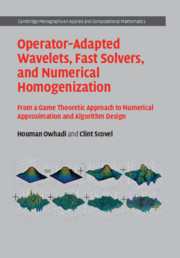 Operator-Adapted Wavelets, Fast Solvers, and Numerical Homogenization
Operator-Adapted Wavelets, Fast Solvers, and Numerical Homogenization Book contents
- Frontmatter
- Dedication
- Contents
- Preface
- Acknowledgements
- Reading Guide
- 1 Introduction
- Part I The Sobolev Space Setting
- 2 Sobolev Space Basics
- 3 Optimal Recovery Splines
- 4 Numerical Homogenization
- 5 Operator-Adapted Wavelets
- 6 Fast Solvers
- Part II The Game Theoretic Approach
- Part III The Banach Space Setting
- Part IV Game Theoretic Approach on Banach Spaces
- Part V Applications, Developments, and Open Problems
- Part VI Appendix
- Bibliography
- Algorithms
- Glossary
- Nomenclature
- Index
- Identities
5 - Operator-Adapted Wavelets
from Part I - The Sobolev Space Setting
Published online by Cambridge University Press: 10 October 2019
- Frontmatter
- Dedication
- Contents
- Preface
- Acknowledgements
- Reading Guide
- 1 Introduction
- Part I The Sobolev Space Setting
- 2 Sobolev Space Basics
- 3 Optimal Recovery Splines
- 4 Numerical Homogenization
- 5 Operator-Adapted Wavelets
- 6 Fast Solvers
- Part II The Game Theoretic Approach
- Part III The Banach Space Setting
- Part IV Game Theoretic Approach on Banach Spaces
- Part V Applications, Developments, and Open Problems
- Part VI Appendix
- Bibliography
- Algorithms
- Glossary
- Nomenclature
- Index
- Identities
Summary
Wavelets adapted to a given self-adjoint elliptic operator are characterized by the requirement that they block-diagonalize the operator intouniformly well-conditioned and sparse blocks. These operator-adapted wavelets (gamblets) are constructed as orthogonalized hierarchies of nested optimal recovery splines obtained fromclassical/simple prewavelets(e.g., ~Haar) used as hierarchies of measurement functions. The resulting gamblet decomposition of an element in a Sobolev space is described andanalyzed.
Keywords
- Type
- Chapter
- Information
- Operator-Adapted Wavelets, Fast Solvers, and Numerical HomogenizationFrom a Game Theoretic Approach to Numerical Approximation and Algorithm Design, pp. 63 - 89Publisher: Cambridge University PressPrint publication year: 2019
